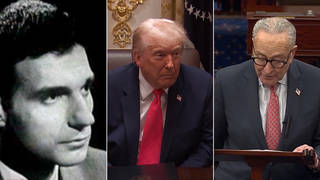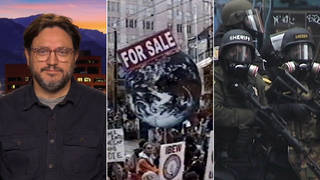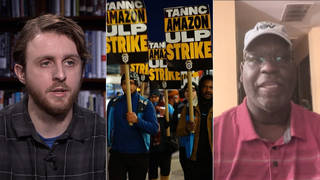
President Biden addressed the economy and labor rights in an address Tuesday to the AFL-CIO convention as delegates elected Liz Shuler to become the AFL-CIO’s first female president and Fred Redmond to be its first African American secretary-treasurer. Longtime labor journalist Steven Greenhouse was there, and says the exclusion of organizers from Amazon and Starbucks from the convention disappointed those calling for the AFL-CIO and Democratic lawmakers to support the youth-led labor movement.
Transcript
AMY GOODMAN: This is Democracy Now!, democracynow.org, The War and Peace Report. I’m Amy Goodman, with Juan González.
President Biden addessed the economy and labor rights Tuesday in a speech to thousands of members of the AFL-CIO at their convention in Philadelphia and laid out his plans to tackle the worst inflation the United States has experienced in decades.
PRESIDENT JOE BIDEN: The problem is Republicans in Congress are doing everything they can to stop my plans to bring down costs on ordinary families. That’s why my plan is not finished and why the results aren’t finished, either. Jobs are back, but prices are still too high. COVID is down, but gas prices are up. Our work isn’t done.
AMY GOODMAN: Biden addressed the AFL-CIO, the country’s largest federation of labor unions, just days after delegates elected Liz Shuler as their first woman president and Fred Redmond to be their first African American secretary-treasurer.
This comes as President Biden has expressed support for unions and used his speech to call on voters to elect candidates who back workers’ and labor rights, including John Fetterman, Democratic Senate candidate in Pennsylvania, and Georgia gubernatorial candidate Stacey Abrams, who was there.
Biden has also met with Amazon and Starbucks union leaders at the White House as both corporations face accusations of illegally firing and retaliating against unionizing workers.
For more, we go to Philadelphia to speak with Steven Greenhouse, longtime labor journalist, who was at the AFL-CIO’s convention when Biden spoke, senior fellow at the Century Foundation, former New York Times reporter, author of Beaten Down, Worked Up: The Past, Present, and Future of American Labor.
Steven, welcome back to Democracy Now! Talk about the significance of where President Biden addressed the catastrophe of the economy right now, in some ways, because of inflation, though jobs are a different story, and all sorts of issues, from the bear market on, and what people on the floor were saying, the thousands of union activists.
STEVEN GREENHOUSE: So, Biden very much felt that, you know, he’s under a lot of criticism because of what’s happening with the economy, especially inflation, and he knows that for the Democrats to do well this November, they really have to win over a lot of blue-collar voters, not just in the Midwest, but in the rest of the country.
So his message was, first, “I’m fighting for you. I’m fighting for workers. I’m fighting for unions. I’m a pro-union president. I passed this big infrastructure bill that will create hundreds of thousands of good middle-class jobs. I want to do more on child care. I want to do more on student debt. The American Rescue Plan, you know, helped tens of millions of American families. I’ve created 8 .6 million jobs as president, more than any other president in such a short time. The unemployment rate is down to 3.6%, which is very, very low.” So, he really said, “I’m doing well on the economy, except we have this inflation problem.”
Second, you know, he was really putting forward a kind of blue-collar message. He was really hitting corporations very hard, saying the big corporations, the billionaires are not paying their fair share, and that the billionaires are paying just 8% of income in income taxes, which is higher [sic] than the average schoolteacher and steelworker. And he got huge applause. And he was — this was one of the best speeches I’ve seen Biden give. He was really very vigorous. And he got a big standing ovation. And I interviewed one union president afterwards who said, “What we as a nation need, what the Democrats need, is for more Democrats to sound just like Biden did today.”
JUAN GONZÁLEZ: So, Steve, how do you deal with this quandary that, on the one hand, unemployment is as low as it’s been in decades, wages have increased substantially, employers can’t find enough workers, and yet there is such disaffection in terms of the masses of the people, especially over inflation and the rising price of gasoline, and President Biden is seen as, really, his heart is in the right place, but his effectiveness is the problem? I’m wondering how you see it in terms of labor, because he didn’t really announce any new initiatives by the administration to the AFL-CIO.
STEVEN GREENHOUSE: Juan, that’s a great question and one that Democrats are trying to figure out, that Biden is trying to figure out. They have, in many ways, done a great job on the economy. You know, I spoke to some top labor leaders: Lee Saunders, head of the American Federation of State, County and Municipal Employees; D. Taylor, president of the hotel workers’ union. They both say the Democrats are not doing a good enough job in getting the message across that they’re fighting for the average workers, that Republicans are blocking them on many things, like trying to enact greater subsidies for child care, and that, you know, he does have this inflation problem, and it’s very hard, but I think he has to do a better job — and it’s extremely hard to do — to say the inflation problem is really not our fault. It’s mainly the fault of the Ukraine war, which is pushing up gas prices and food prices. It’s the supply chain problems created by the pandemic. And the Republicans are doing a great job saying, “Oh, it’s all Joe Biden’s fault.” And Joe Biden and the Democrats aren’t doing a good enough job saying, “It’s not our fault. It’s due to problems beyond us.”
But, you know, a problem all presidents face is the buck stops here, and if inflation is high on your watch, you know, you’re going to — people are going to blame you. So that’s why Biden has to do a much better job showing America’s voters, America’s workers that “I am fighting for you,” and that “I am trying to lower inflation, and I have done a great job creating these 8.6 million jobs and lowering the inflation rate — sorry, lowering the unemployment rate,” and needs to make clear that, except for inflation, the economy is really doing quite well and that the rebound from the pandemic, from the recession, has been very rapid. It’s a hard message, but they really have to hammer it and hammer it and hammer it.
JUAN GONZÁLEZ: And I wanted to ask you about the changing climate, especially among young people in the United States, regarding unions. We’ve covered here on this show many of the successes, of over 150 Starbucks retail stores have unionized. But the Starbucks stores, although there are many of them, they’re small numbers of workers. At that one Amazon plant in Staten Island that unionized 8,000 workers, that’s more than double what probably all the Starbucks union campaigns have succeeded in recruiting to the labor movement so far. I’m wondering your sense of how the AFL-CIO and the new president is going to deal with the issue of organizing on a massive scale, given the fact that so many young people now are predisposed to unions.
STEVEN GREENHOUSE: I just finished a big story on that for The Guardian. So, yeah, on one hand, the Starbucks unionization drive and the Amazon victory in Staten Island, they’re, in many ways, as you, Amy and Juan, you know, have been like the two biggest, most inspiring unionization efforts in decades. And it’s really — they’ve really jazzed millions of young workers about unions. And, you know, this recent poll, recent study I source, said 74%, three out of four young workers aged 18 to 24, say they would vote to join a union if they could. So, young workers are really jazzed about unions. We’re seeing it not just at Starbucks and Amazon, but at REI and Google Fiber and Amazon and at — you know, museum workers and undergraduate workers at Dartmouth and Grinnell and Wesleyan and Hamilton have unionized. So there’s huge excitement among young workers to unionize.
And, you know, so, coming into this AFL-CIO convention here in Philadelphia, there was a lot of pressure, a lot of questions facing the AFL-CIO, that: Are you going to step up to the moment? Are you going to — are you, as the nation’s big established labor federation, going to do anything to really push, help this youth-fueled unionization movement grow?
So, Liz Shuler, who was elected to a full four-year term as AFL-CIO president, after succeeding Richard Trumka, her predecessor, when he died of a heart attack in August — Liz Shuler announced what she thought — what she says is a bold plan, that the AFL is going to set out to — the AFL’s 57 unions are setting a goal of unionizing an additional 1 million workers over 10 years. And she says, “That’s great. This is the first time we’re creating measurable goals for unions to increase their membership.” And 1 million over 10 years really translates to a 1% increase in union membership per year.
Now, some people say that after unions have lost members year after year, it’s a real substantial goal to try to increase membership by 1% a year. But I spoke to some well-known union leaders — you know, D. Taylor of the hotel workers, Sara Nelson of the flight attendants, Mark Dimondstein of the postal workers’ union — saying 1%, that the 1 million goal is just not enough, that this is really a time, a moment when millions of workers are really inspired about unions, they’re jazzed up, they’re eager to unionize, so that they’re criticizing this 1 million goal as falling far short. They say that the AFL has to be far bolder.
And some union leaders I spoke to here say it’s weird, it’s disappointing that among the hundreds of speakers at the AFL-CIO convention, there are no Starbucks workers and no one from the Amazon Labor Union, which won in Staten Island. And it’s no coincidence that, you know, those unions — the Amazon Labor Union, an independent union, and the Starbucks workers, who are joining Workers United, which is part of the SEIU — the SEIU is not part of the AFL-CIO, so workers from those non-AFL-CIO unions have not been invited to this big convention. And some people say, “We talk about labor solidarity. We talk about pulling all together. So, why is it that workers from some of the most exciting unionization drives in decades are not invited to speak at this convention?”
AMY GOODMAN: Why is it? And finally, Steven Greenhouse, you talk about this being the “John L. Lewis moment” for unions. What do you mean by that?
STEVEN GREENHOUSE: So, John L. Lewis was the president of the United Mine Workers in the 1930s, when that was the richest, biggest, most powerful union in the nation. In the 1930s, there was the beginning of unionization of mass production industries. You know, Henry Ford really began huge mass production lines. In the 1930s, there was this effort among steelworkers and autoworkers to unionize, but the American Federation of Labor at the time really didn’t want to help these people unionize. The American Federation of Labor were a bunch of craft unions, carpenters, bricklayers. And they thought, “We don’t want to help this mass unionization by this group” they saw as largely unskilled workers. And John Lewis said, “These folks, these mass production workers, are the future of the labor movement. We’re crazy if we don’t help them unionize.”
So, John Lewis, backed by some other unions — the textile workers, the garment workers — you know, got behind, funded this effort to unionize these mass production workers. You know, thanks to the big treasury of the mine workers, they hired 500 organizers to organize autoworkers and machinery worker and steelworkers. And that produced the biggest surge in unionization in American history. The nation went from 12% of the workforce being unionized in 1935 to basically over 30% unionized in 1946, ’47. And that was thanks to the efforts of John Lewis and the so-called Congress of Industrial Organizations. So they met the moment. They stepped up.
And the theme of this AFL-CIO meeting now is building a movement to meet the moment. And some people are questioning whether the AFL-CIO’s goal of unionizing 1 million over 10 years really meets the moment. They’re saying that the federation should do more. Liz Shuler, who’s very much a consensus leader, she says, you know, the 57 unions of the AFL, this is what we could get them to agree to. And some people say this is lowest common denominator unionism. Liz Shuler and the federation should do more to push unions to do more. And Shuler is kind of saying, after years of losing membership, it’s an ambitious goal even to do 1 million over 10 years. So there’s a real tug-of-war. I see many unions, many labor academics, many labor activists are saying, “Look, 1 million, organizing 1 million over 10 years just ain’t enough,” and they’re pushing, pulling the AFL-CIO, the nation’s unions to do a lot more.
AMY GOODMAN: Steven —
STEVEN GREENHOUSE: And there will be, likely —
AMY GOODMAN: Ten seconds.
STEVEN GREENHOUSE: — [inaudible] workers in SEIU that will continue doing a lot of unionization. Sorry.
AMY GOODMAN: Steven Greenhouse, thanks so much for being with us, longtime labor journalist, senior fellow at Century Foundation. His book, Beaten Down, Worked Up: The Past, Present, and Future of American Labor.
Next up, President Biden, when he was running for president, said that Saudi Arabia and Mohammed bin Salman should be pariahs. He has reversed himself. We’ll bring you more, 30 seconds.












Media Options